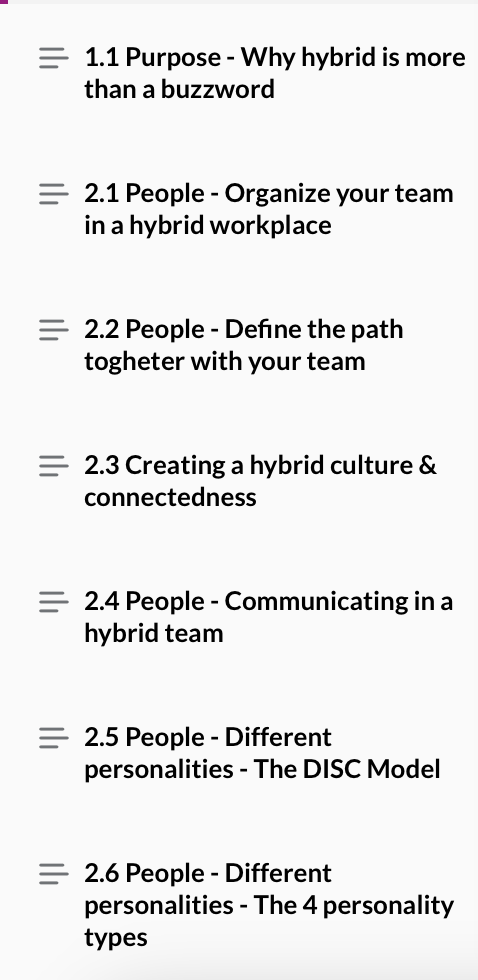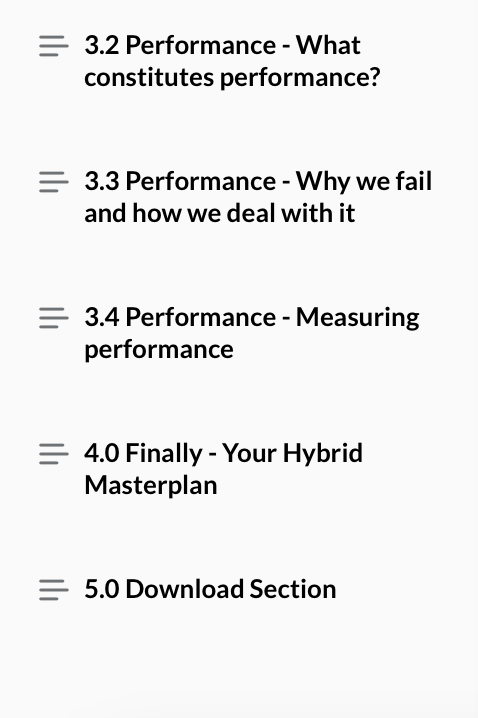
Purpose – Why Hybrid is more than a Buzzword
Purpose – Why Hybrid is more than a Buzzword
Prefer to listen to the article? Click below to access our AI speech-generated audio. However, if you want to read it as usual, keep scrolling.
Purpose – Why Hybrid is more than a Buzzword
Is hybrid just a new trend? And what do different life realities of our employees have to do with it? In his new Rise Course, our MDI trainer and partner Peter Grabuschnig shares all his knowledge on Hybrid Leadership.
It offers a reflective look at your leadership behavior in times of new work, work location, and increasing flexibility. In this blog article, we will introduce you to the first pillar of the 3P model – Purpose. Enjoy reading!
What does hybrid even mean?
Even though the word hybrid can have different meanings in different contexts, one thing is clear – Hybrid is a mixture of two or more components. When we refer to Hybrid, we mean a combination of different workplaces, such as the office, the home office, or even abroad.
However, if we are honest, hybrid is still not perfect. That’s why I recommend considering how to enable more flexibility for employees in the future.
So who and what does this hybrid lifestyle have an impact on?
1. Ourselves:
In many companies you can now decide for yourself whether to work from home or at the office. This has significantly increased our flexibility.
2. The team:
Simply talking to our colleagues or going for a quick coffee break is not as easy as it used to be. Also, when planning office times, it is more likely to exclude others by forming groups or avoiding certain colleagues.
3. Leadership:
This goes far beyond the team level. It requires transparent communication, clear goals, and a strong commitment to the company. Maintaining performance and much more is expected of you as a leader.
4. Company:
Many companies are already considering what hybrid means for them and what benefits they can derive from it. One international client I advised even had the most productive year after the change to a hybrid setup.
Another customer decided to reduce the number of office buildings to 60%. The latter, however, is not a sustainable solution as there are days on which more people will want to go to the office.

Why should I as a leader care about leading a hybrid team?
Around 45% of the global workforce, at least according to McKinsey, can do hybrid work. Whether we like it or not, for these 45% the newly gained flexibility plays an enormous role in balancing work and life.
Hybrid is also exciting from an evolutionary point of view – we went through the agricultural era, the age of industrialization, and the labor movement. Today, our computers and smartphones dictate when and where we work.
By deciding where we work, we are now able to balance our work and personal lives much better. Not only that, it has also improved other aspects:
1. Technology:
We had to learn how to use new technologies and things are now working that we couldn’t have thought possible a few years ago. For example, taking part in an online workshop with the whole team from home.
From a technical point of view, a lot has developed in the last few years. Some new technologies such as VR will digitalize our collaboration even further in the future. It would, for example, make it possible to meet in a virtual room in 3D instead of just looking at your laptop in two dimensions.
Other developments such as AI or augmented reality are also revolutionizing the way we collaborate remotely.
2. Employees:
We can no longer avoid a hybrid setup – that is mainly because our employees have demanded it and even threatened to quit if they can’t work in a flexible environment.
So to be an attractive employer today, you need to think carefully about what you need your employees to do in the office, where flexibility makes sense, and what you can offer them.
Let’s now take a closer look at the individual life realities of our team members…
People have different expectations and life concepts, their job has to suit them. If it doesn’t fit, you look for another job. The fact that many aspects of our work can be taken over by machines gives us more freedom to create.
The classical performance-based society which encourages a lot of overtime and focuses on presence is becoming increasingly outdated.
A Microsoft study has shown the situation regarding hybrid working among employees and their individual preferences. Two out of 10 respondents would like to work exclusively from the office. This can be due to a variety of reasons, such as feeling lonely at home.
Surprisingly, 3 out of 10 don’t want to go back to the office at all. This could be due to care obligations, for example. Half of the respondents want a combination. Some prefer one home office day per week, while others would like to have more. These figures give us an idea of how many different life realities we as leaders now have to juggle.

The one-size-fits-all approach is no longer possible and there is no uniform solution that satisfies everyone. We have to respond individually to each employee and develop a suitable solution for the whole team.
The work environment has changed considerably, but the requirements for leadership have remained the same. Employees still expect recognition, fairness, open and transparent communication, a motivating work environment in which they can develop, and flexibility to balance life and work.
The leadership priorities have shifted. For example, in the hybrid daily routine, much more attention needs to be paid to communication, so that everyone knows everything they need to know.
What has changed is not the content but the context in which we work. Thus, we need to adapt our systems and behavior to the context to be successful.
I would like to give you one more piece of food for thought. I would like to invite you to take a retrospective look at the last 6 months of your work.
- What experiences have you had in terms of hybrid working? What has (not) worked well?
- What were/what are your challenges?
- What challenges will your team face in the future? What would you like to develop or continue from what you have already experienced and tried out?
You can do this task individually, with a colleague, or even in a small workshop with your whole team.
We hope you have enjoyed this snippet from Peter’s Rise course! You can contact us if you are interested in this course or follow along on our blog, where we will share other content of the course as well.

Peter Grabuschnig
Trainer, Coach & MDI Partner
Peter is a partner and trainer at MDI, advising major international corporations on implementing hybrid work policies and building a hybrid work and leadership culture.
He is considered an expert in training design. With his Webinar Guru Framework he has developed a tool that helps to design training content for successful and activating virtual learning.











